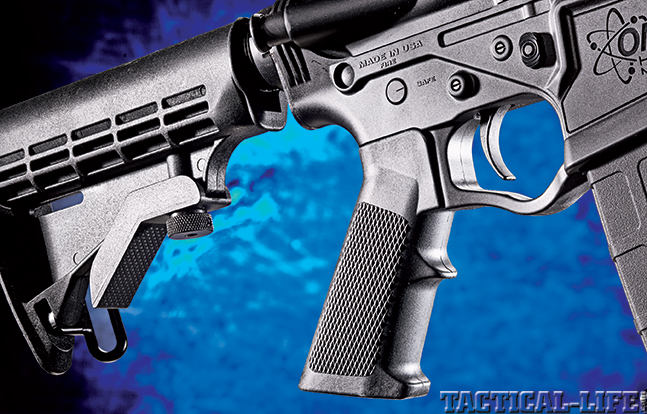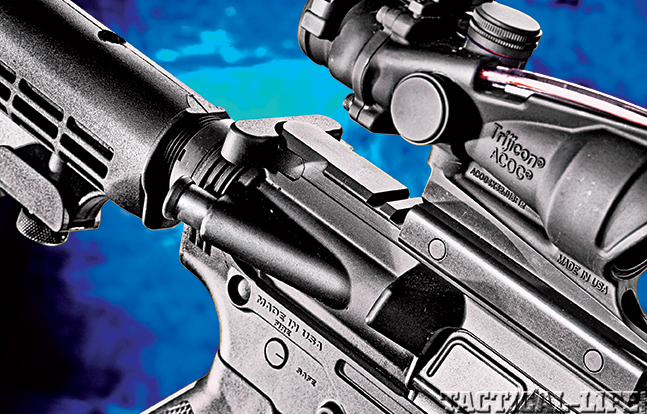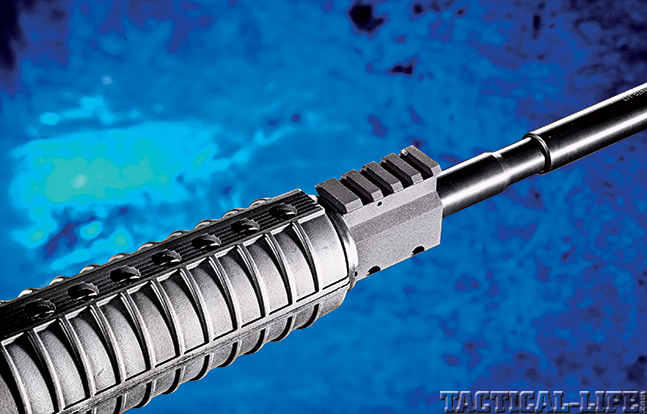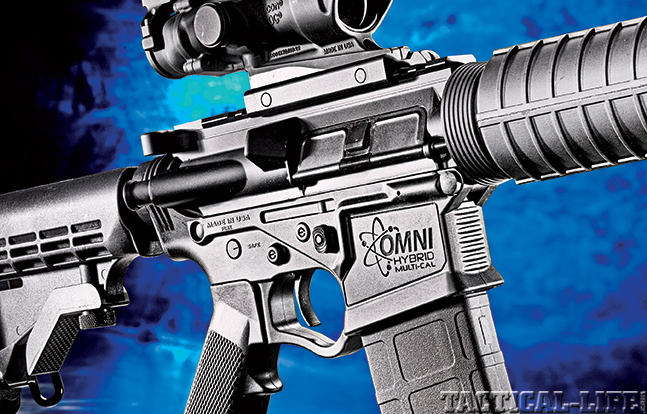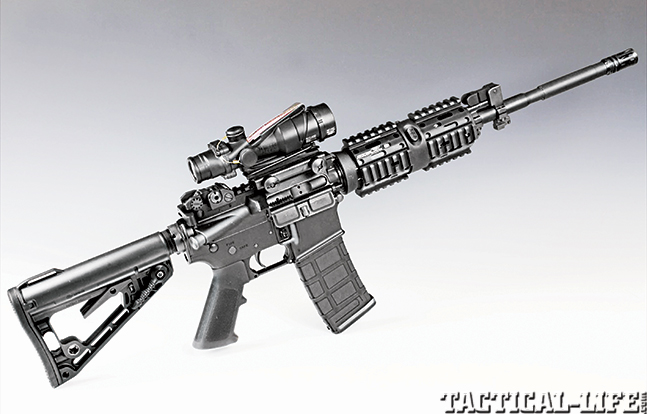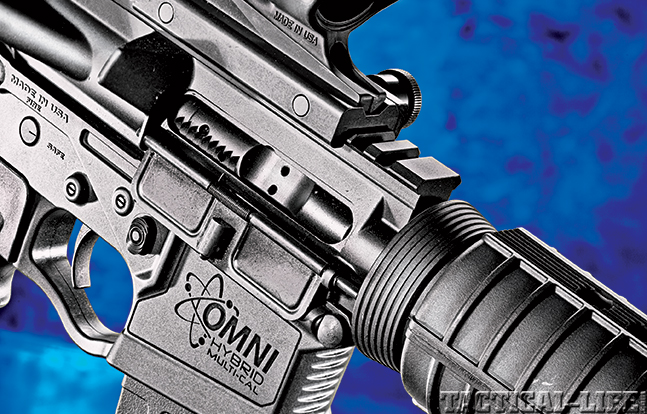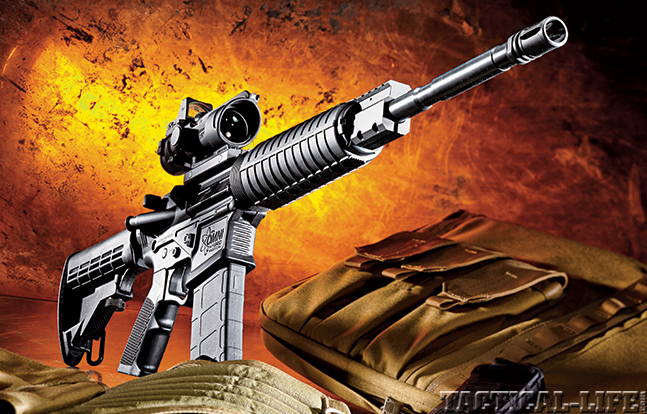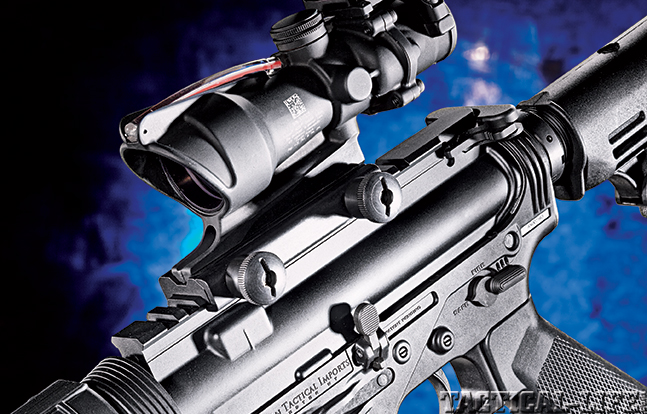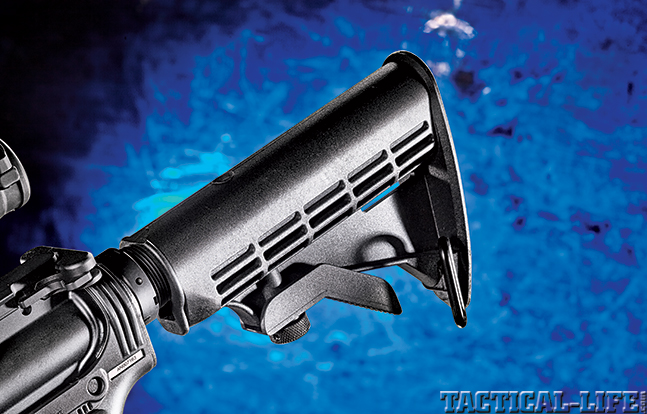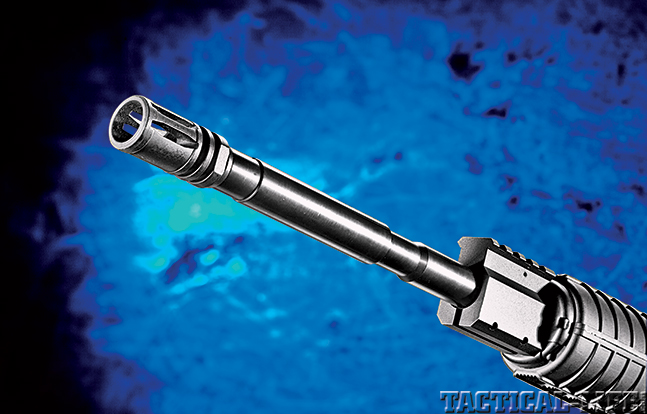The genesis of the AR rifle goes back more than half a century. At that time, building a military rifle out of aluminum was groundbreaking, but today we are still doing it essentially the same way. While the AR platform has seen significant advances over the decades, they pale in comparison to technological advances seen in other products over the same time period. Think of cars today compared to 50 years ago.
RELATED: American Tactical Omni Hybrid | VIDEO
There is, however, a whole new breed of outside-the-box thinkers who are bringing new technology to the AR, and among these is American Tactical. The new Omni Hybrid AR developed by American Tactical mixes the old and the new for a greater amalgamation of its component parts. This is a direct-impingement, semi-automatic AR carbine chambered in 5.56mm NATO.
Advertisement — Continue Reading Below
Polymer Lower
The American Tactical Omni Hybrid’s most notable feature, especially for those who put their rifles to hard use, is the new fiberglass-composite polymer lower receiver. Of course, polymer receivers are not new, going back more than 20 years, and many manufacturers still use them. ATI, however, may have perfected the polymer lower receiver; the secret is that it is not entirely polymer. The weak spot on these types of receivers is that they have flex, unlike solid aluminum receivers, and a typical weak spot is the buffer tower, where the buffer tube screws in.
To resolve this, American Tactical has embedded a solid zinc metal alloy insert at this spot with the threads to attach the buffer tube and which extends down to catch the rear takedown pin for added strength. The metal insert also contains the rifle’s serial number, which appears on the left side of the receiver, just behind the rear takedown pin. The metal insert does slightly detract from one of the selling points of polymer—the reduced weight over aluminum—but still, the Omni Hybrid lower receiver is half an ounce lighter than a comparable aluminum lower. What it loses in weight reduction is more than made up in strength, as several videos on ATI’s website demonstrate.
Advertisement — Continue Reading Below
ATI performed drop tests with a loaded rifle from 4 feet onto a hard surface and then function-checked the gun. There was no firing on impact, no damage and no change in performance. The receiver also underwent a “hang test,” where 285 pounds of weight (more than the mil-spec test) was applied directly to the buttstock, again with no damage. A crush test with a 11,000-pound plus forklift followed, and the Omni Hybrid showed no damage and continued to function as normal. Essentially, this combination of polymer and metal has the benefits of strength, weight, flexibility and durability that has advantages over most other all-material receivers.
“A crush test with an 11,000-pound forklift followed, and the Omni Hybrid again showed no damage and continued to function as normal.”
Another benefit of a polymer lower is that it is very scratch resistant as well as completely water- and corrosion-proof. It won’t dent and will never lose its finish. Polymer also has the added benefit of dissipating heat very well, and it won’t get too hot to touch even if it’s left in the hot sun. The same goes from extreme cold conditions, and unlike metal, there is no chance of getting frostbite from touching it in extreme cold temperatures.
Advertisement — Continue Reading Below
Since polymer can be molded anyway the manufacturer chooses, the Omni Hybrid lower receiver has a resemblance to the many custom billet receivers on the market today. It also features an aggressively beveled magazine well which aids in faster magazine changes. The front of the magazine well has horizontal cuts to provide a firmer grasping surface for those who choose to grip the front of the magazine well with their support hand instead of the forend. The integral triggerguard has been enlarged to allow for gloved hand use.
The fence around the magazine release button is smaller and less extensive than that found on traditional aluminum lower receivers, and it does leave the release slightly more exposed, which could cause an unintended magazine release, but it also has the benefit of helping with faster magazine changes. All of the controls are standard for a right-handed shooter, and the safety selector is marked “Safe” and “Fire” on both sides of the receiver.
I only had one issue with the ATI polymer lower receiver: The magazine well seems slightly oversized. The included GI magazine had a lot of side-to-side and front-to-back play when installed in the rifle, and this caused some feeding malfunctions. I tried both a Magpul PMAG and the Lancer Systems L5 Advanced Warfighter Magazine (L5AWM), and those worked with zero issues, although they still seemed to fit a bit loosely.
Advertisement — Continue Reading Below
The polymer receiver is very attractive, with the Omni logo on the right side. The polymer is reinforced and a bit thicker than a standard aluminum receiver, so the rear takedown pin is actually somewhat countersunk and required a tool for disassembly. The lower also sticks out a bit past the upper receiver on either side, but this in no way affected its functioning. The fit between the upper and lower receivers is also very tight, with literally zero play. This is a good thing, but it also means that disassembly required a bit of tapping on the receiver pin.
Upper Receiver
The upper receiver is a standard flattop, aluminum model with a T-marked Picatinny top rail and “American Tactical” laser-engraved on the left side. The 16-inch steel barrel is not chrome-lined; instead, it sports a Melonite coating. This involves using Melonite as a salt-bath nitrocarburizing casehardening that leaves a nitride finish directly on the metal that is much thicker than other finishes. The result is an extremely corrosion-resistant barrel with improved wear and fatigue resistance and lubricity. This also dispenses with the need for a chrome-lined barrel and can actually improve accuracy, as chrome lining can be unevenly applied.
Advertisement — Continue Reading Below
“Essentially, this combination of polymer and metal has the advantages of strength, weight, flexibility and durability over most other all-material receivers.”
On the outside, the barrel has an M4 profile and appears to have a slightly shiny blued finish instead of the more commonly seen Parkerized finish, since the Melonite also does away with the need for Parkerizing. As with most high-quality 5.56mm ARs, the Omni Hybrid has a 1-in-7-inch twist rate, which allows the barrel to stabilize even the heaviest bullets. The barrel is topped off with a standard A2 flash suppressor on threads, which makes installing different suppressor ready muzzle devices easy.
The ATI rifle has a carbine-length gas system and a screw/pinch, aluminum gas block with 2 inches of Picatinny rail on top. This makes the rifle conveniently optics ready, with no front sight tower to get in the way of low-magnification optics, and it can also easily accommodate a folding front backup sight.
Advertisement — Continue Reading Below
The standard, round, plastic handguards have internal aluminum heat shields that worked well on the range. These can be easily replaced with various aftermarket railed handguards for those who need space for accessories. The rest of the furniture is standard AR, with a mil-spec, A2-style pistol grip and a collapsible buttstock on a commercial buffer tube that is adjustable for length of pull for use with heavy clothing or body armor.
Internally, the ATI rifle uses an M16 bolt carrier group—as opposed to a commercial bolt—that is stronger and heavier to ensure longer and more reliable operation. It should be noted that mil-spec M16 bolt carriers are legal to install in semi-auto rifles. The rear of the barrel extension features standard AR rifle feed ramps rather than M4 feed ramps. M4 ramps are cut wider and lower than on standard AR rifles to help ensure more reliable feeding from the magazine under harsh conditions.
Range Time
Advertisement — Continue Reading Below
At barely 6 pounds unloaded, this was one of the lightest ARs I have tested, and it made handling fast and easy while limiting any fatigue from an extended range session using an EOTech holographic sight and a 3x magnifier. The mil-spec, single-stage trigger exhibited some initial creep but broke cleanly at about 6.5 pounds. While certainly not a precision trigger, it was better than most standard AR triggers and exhibited none of the usual grittiness one often encounters.
For the accuracy portion of the evaluation, I fired the Omni Hybrid from a benchrest at 100 yards using a Trijicon 3-9x40mm TR20-2 AccuPoint scope with a mil-dot crosshair reticle. The carbine’s accuracy was excellent for a patrol rifle, with at least one group measuring sub-MOA, and the rifle showed a distinct preference for heavier ammunition.
The ATI Omni Hybrid certainly has a lot going for it—performance, reliability, accuracy and, possibly most significant to many shooters, price. For those who want to take advantage of this improved polymer lower receiver to build their own rifle, ATI also sells them stripped for less than $50. Also, every OMNI Hybrid, from stripped lower to built rifle comes with a Magpul PMAG. All together, this is a very hard to beat combination.
Advertisement — Continue Reading Below
For more information, visit americantactical.us or call 800-290-0065.

